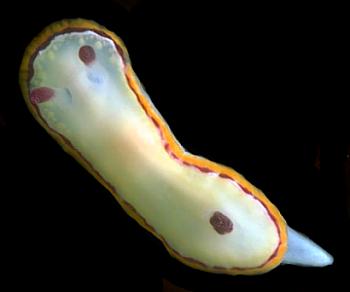
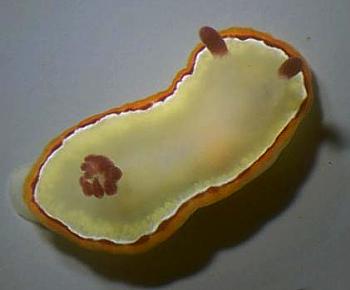
Chromodoris rubrocornuta
Rudman, 1985
Order: NUDIBRANCHIA
Suborder: DORIDINA
Superfamily: EUDORIDOIDEA
Family: Chromodorididae
DISTRIBUTION
Known at present only from the western Pacific from north Queensland, Australia, Marshall Islands, Hong Kong and Japan.
PHOTO
Hoi Ha, Flynn Point, 3m, Hong Kong, 18 April 1982, AM C138518. Holotype. PHOTOS: Brian Darvell.
This is one of the many species of chromodorids which are white with either red, yellow or orange mantle borders, or a combination of two or three bands. C. rubrocornuta is one of a group of species, which I have called the Chromodoris fidelis colour group, which have an orange outer band at the mantle edge and an inner, often broken band of pink, red or purple. Its name is derived from its red rhinophores. Largest known specimen 13 mm long preserved.
If the animals in Scott Johnson's messages below, showing variation in the background colour of the mantle from white to yellow, are in fact this species then it seems the edge of the rhinophore lamellae can be white. In the photographs available to me from Hong Kong, the rhinophore club appeared a translucent red.
References:
•Rudman, W.B. (1985) The Chromodorididae (Opisthobranchia: Mollusca) of the Indo-West Pacific: Chromodoris aureomarginata, C. verrieri and C. fidelis colour groups. Zoological Journal fo the Linnean Society, 83: 241-299.
•Rudman, W.B. & Darvell, B.W. (1990) Opisthobranch molluscs of Hong Kong. Part 1. Goniodorididae, Onchidorididae, Triophidae, Gymnodorididae, Chromodorididae, (Nudibranchia). Asian Marine Biology, 7: 31-79
Rudman, W.B., 2000 (December 30) Chromodoris rubrocornuta Rudman, 1985. [In] Sea Slug Forum. Australian Museum, Sydney. Available from http://www.seaslugforum.net/find/chrorubr
Related messages
Chromodoris rubrocornuta from American Samoa
May 16, 2005
From: Emmanuel Tardy
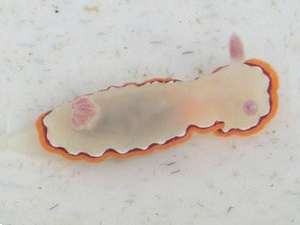
I found this species, diving off Utulei, in front of the sewage station in Pago Pago Bay (American Samoa). The bottom is sandy and muddy, not a pristine area at all, but quite rich for molluscs. Is it Chromodoris fidelis?
Locality: Utulei, Pago Pago Bay, American Samoa. Depth: 8-10 m. Length: 10 mm. 8 March 2005. sand - mud. Photographer: Emmanuel Tardy
Emmanuel Tardy
emmanuel_tardy@hotmail.com
Tardy, E., 2005 (May 16) Chromodoris rubrocornuta from American Samoa. [Message in] Sea Slug Forum. Australian Museum, Sydney. Available from http://www.seaslugforum.net/find/13776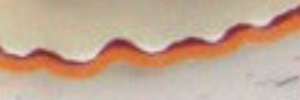
Dear Manou,
This is an interesting find. It has a superficial similarity to some colour forms of Chromodoris fidelis but that species always has black gills and rhinophores, although the rest of its colour pattern is quite variable. Your animal is Chromodoris rubrocornuta. The gills are a translucent red and the mantle margin has a broad outer orange band and then a deep reddish band which broadens then narrows along its inside edge to give a characteristic pattern of red scalloping. There is then a narrow line of opaque white separating the red from the translucent white of the rest of the mantle.
Best wishes,
Bill Rudman
Chromodoris rubrocornuta from the Philippines
November 28, 2003
From: Erwin Köhler
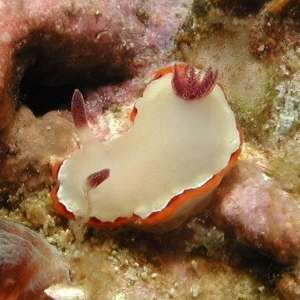
Dear Bill,
Here is the next one from the Philippines. It looks like a very strange colour-variant of Chromodoris fidelis, with the orange-red border of the mantle and a thin dark red line next,
but it has red gills and rhinopores. C. fidelis should have black ones.
data:
Philippines, Malapascua island, Logon,
divesite "Gato Cave"
length 19mm
depth 14m
date 11 Oct. 2003
Any idea?
Cheers,
Erwin
Erwin@Philippine-Sea-Slugs.com
Köhler, E., 2003 (Nov 28) Chromodoris rubrocornuta from the Philippines. [Message in] Sea Slug Forum. Australian Museum, Sydney. Available from http://www.seaslugforum.net/find/11534Thanks Erwin,
This is Chromodoris rubrocornuta. As you have noticed it has similarities and differences to C. fidelis. The colour of the gills and rhinophores are an very obvious difference. This is not a commonly reported species so any information on it is welcome
Best wishes
Bill Rudman
Hong Kong Chromodoris rubrocornuta
January 29, 2002
From: W.B. Rudman & B.W. Darvell


Here is some information and photos on Chromodoris rubrocornuta from Brian Darvell's Hong Kong collections.
Similar in colour to Chromodoris fidelis but differs in having red gills and rhinophores and in having a broken irregular red line between the orange border and the white of the rest of the mantle. Largest known specimen 13 mm long preserved.
PHOTO:
Hoi Ha, Flynn Point, 3m, Hong Kong, 18 April 1982, AM C138518. Holotype. PHOTOS: Brian Darvell.
Hong Kong Collection Records:
AM C134757, 25 July 1982, Site 1.4, Ngo Mei Wan, Crescent Is., Mirs Bay, 9 m. AM C137066, 10 October 1982, Site 1.34, Tsing Chan, Crooked Harbour, 6 m. AM C138518, 18 April 1983, Site 5.76, Datum Rock, Hoi Ha, Tolo Channel, 1-4 m. Depth range: 1-9 m.
Reference:
• Rudman, W.B. & Darvell, B.W. (1990) Opisthobranch molluscs of Hong Kong. Part 1. Goniodorididae, Onchidorididae, Triophidae, Gymnodorididae, Chromodorididae, (Nudibranchia). Asian Marine Biology, 7: 31-79
Best wishes,
Bill Rudman & Brian Darvell
Chromodoris rubrocornuta from the Philippines
May 24, 2001
From: Jeff Rosenfeld
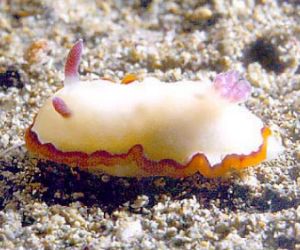
Hi Bill,
We called this photo Chromodoris sp.
(http://www.oz.net/~vibrant/chromodoris29_anilao11.html). It was taken in Anilao, Luzon Island, Philippines in April, 2000.
If you could provide a positive identification and any information you have,
it would be greatly appreciated.
Jeff
jhrosenfeld@seattleschools.org
Rosenfeld, Jeff, 2001 (May 24) Chromodoris rubrocornuta from the Philippines. [Message in] Sea Slug Forum. Australian Museum, Sydney. Available from http://www.seaslugforum.net/find/4387Dear Jeff,
This is Chromodoris rubrocornuta. It is charcterised by the reddish gills and rhinophores and the thin, often broken, submarginal red border to the mantle.
Best wishes,
Bill Rudman
Colour variation in Chromodoris rubrocornuta
January 1, 2001
From: Scott Johnson
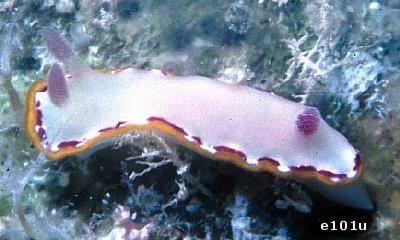
Hi Bill,
Here's one more for the Forum species list. Chromodoris rubrocornuta shows some interesting variation throughout the Marshall Islands atolls. The specimen e181b is one of six found beneath rocks in shallow water (3 meters or less) during an expedition to Bikini Atoll in the early 80s. The specimens, which were mostly from about 8 to 15mm in length, were all of similar color. A single specimen found at Rongelap Atoll, less than 100 miles to the east, lacked color in the rhinophores and gills (e181r). Another 150 or so miles east, two specimens at Utirik Atoll both had a bit more of the purple color in their margins (e181u). All these were found during short expeditions, but curiously, extensive collection at Enewetak Atoll over nearly three years found no specimens, although Chromodoris galactos (separate message) is quite similar in coloration. Twenty or more specimens that may also be C. rubrocornuta have been found at Kwajalein Atoll, about 200 miles south of Bikini, but they differ in having bright yellow mantles (separate message).
Scott
johnson@kmr.ll.mit.edu
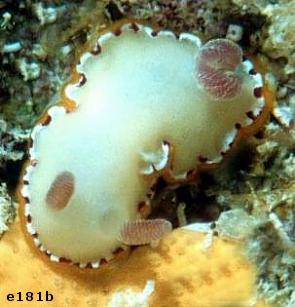
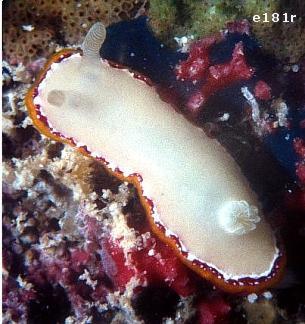
Dear Scott,
Now I really can't delay putting up some more of these white chromodorids with orange, yellow and reddish borders. I also promised some time ago to put up some more Hong Kong records so this is a chance to do that as well.
These are intersting photos, even if they are a little less than straightforward. Firstly the white edge to the rhinophore lamellae is interesting. I have never seen this species alive and in all the photos I have seen the rhinophore clubs appear a translucent red with no distinct white edging to the lamellae. I don't know if that means the species is variable, or the photos I have seen are not quite focussed. I must recheck my Hong Kong photos.
Secondly, I would not be surprised if 181r is Chromodoris galactos rather than a strange variant of C. rubrocornuta. I guess when we have only photos to look at its a question of which colour features you give the most weight. I feel the purplish border with small white specks is good character of C. galactos but we would need some more specimens from the same area to get some idea of local variability.
Best wishes,
Bill Rudman.
Chromodoris rubrocornuta from Kwajalein?
January 1, 2001
From: Scott Johnson

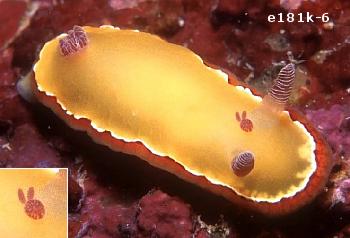
Hi Bill,
To accompany my earlier message on Chromodoris rubrocornuta, here are two images of what is possibly the same species from Kwajalein Atoll. The 20 or more Kwajalein specimens found so far all have bright yellow dorsal coloration, but otherwise match more typical C. rubrocornuta. The e181k-6 photo is interesting both for the commensal copepod and for the mantle glands visible around the anterior margin.
Scott
johnson@kmr.ll.mit.edu
Johnson, S., 2001 (Jan 1) Chromodoris rubrocornuta from Kwajalein?. [Message in] Sea Slug Forum. Australian Museum, Sydney. Available from http://www.seaslugforum.net/find/3445Thanks Scott,
It is certainly quite a distinct yellow colour, though one of the photos at the top of the page from Hong Kong shows the mantle with a yellowish tinge. Perhaps it is like the colour variation I have shown for the southeastern Australian species Noumea haliclona.
Your copepod commensal is also very interesting. In Lifou I met a copepod expert who has taken an interest in those found associated with nudibranchs. Once I get my photos organised I plan to post a few photos on the Forum and prepare a page on this interesting association.
Bill Rudman.
